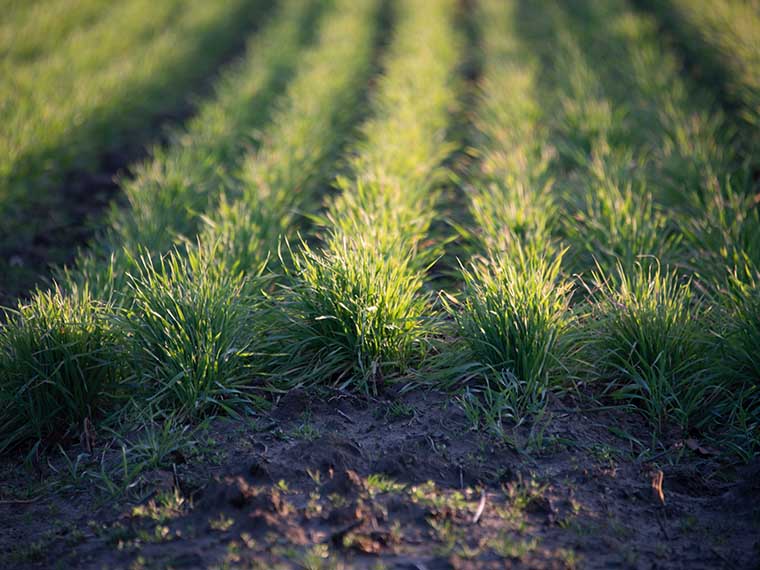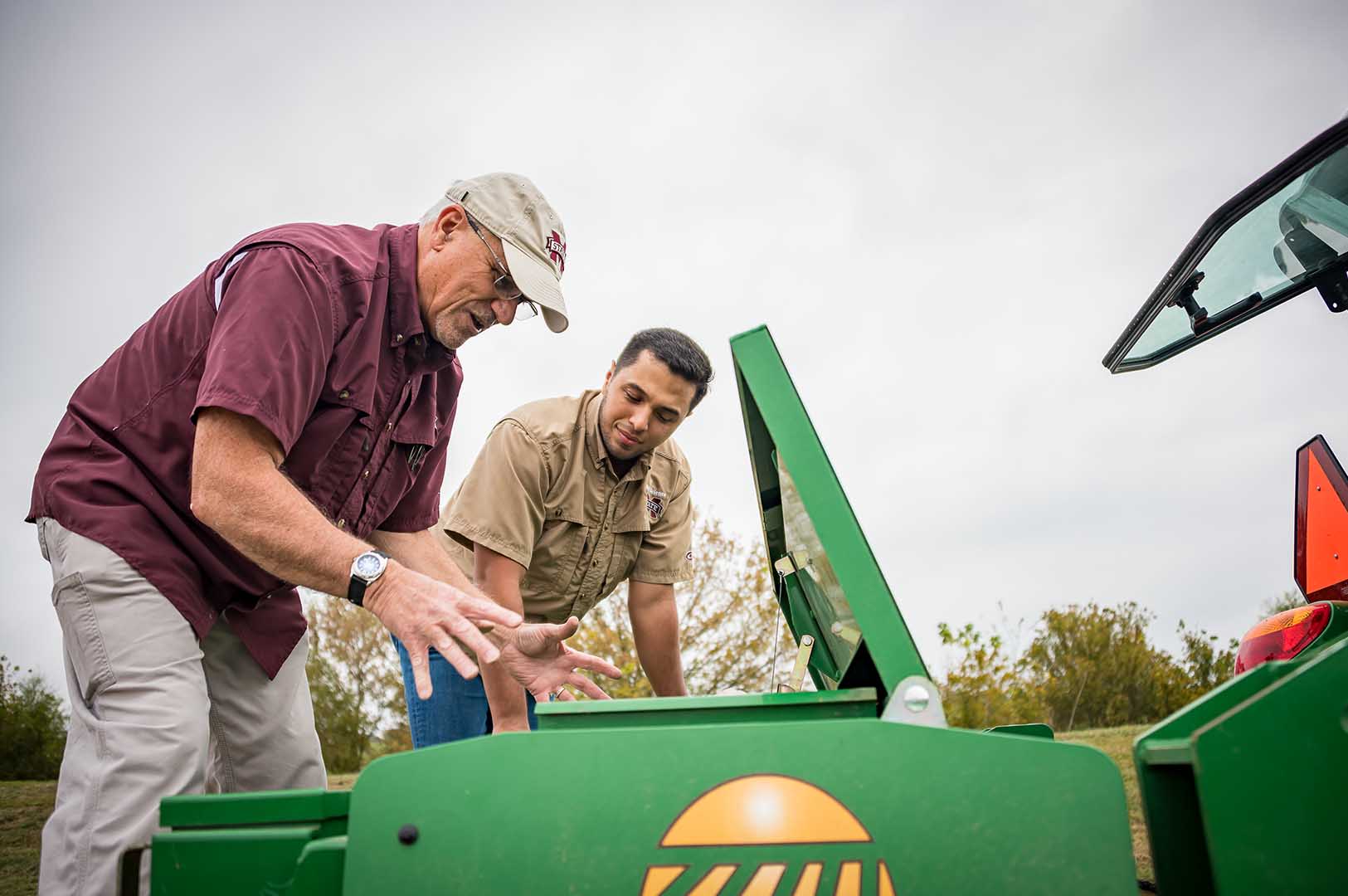The information presented on this page may be dated. It may refer to situations which have changed or people who are no longer affiliated with the university. It is archived as part of Mississippi State University's history.
Cover crops improve soil health and water retention, prevent erosion, and suppress weeds. Some cover crops can do more. Legume cover crops, for instance, fix nitrogen from the atmosphere and deliver it back into the soil. To help quantify benefits and determine better ways to implement a complete cover crop system, researchers in the Mississippi Agricultural and Forestry Experiment Station are uncovering the best methods to deploy these beneficial plants.
Dr. Jac Varco, Triplett Endowed Chair in Agronomy, has been studying cover crops for more than 35 years. His research centers on improving nutrient use efficiency and soil quality and health, which are factors often influenced by cover crops.
"Our goal is to provide evidence-based data that gives producers options when it comes to cover crops," Varco said. "Our research shows that cover crops combined with other practices such as reduced tillage increase organic matter and microbes in the soil, contributing to overall soil health."
In one recent study, Varco is investigating the effects of cover crops on biomass, nitrogen dynamics, and yield in strip-tilled corn production systems. Over the course of three years, the team planted a combination of fall cover crops that were terminated in the spring. After that, the plots were strip- tilled and corn was planted. Corn yield data was collected after harvest the next fall.
The team evaluated three types of legumes-Persian clover, crimson clover, and berseem clover-alongside two other types of cover crops-cereal rye and tillage radish. Varco said the researchers sought to determine if two cover crops used together resulted in greater biomass and more nitrogen availability for the corn planted in the late spring.
"Evidence supports a mixture of cover crops as a viable solution towards increasing ecological stability and resilience for row crops by contributing greater biomass productivity and improving availability of nitrogen," Varco said.
Graduate student Eduardo S. Garay, who is on the project, said the team aims to get back to the basics when it comes to delivering nitrogen to the corn plant.
"We aim to better understand the benefits of a legume plus cereal rye and legume plus tillage radish mixture without adding any other nitrogen input to better quantify and contrast the sole sustainable effect that the mixtures could provide to the producer," he said. "While there is plenty of cover crop research available, there is limited data that evaluates biculture cover cropping systems in the South, which represents 30 percent of the total farmland in the country. In this case, the study uses these biculture mixtures in a strip tillage environment."
Garay said that legumes combined with cereal rye resulted in increased biomass but decreased nitrogen availability. He pointed out that over time, by the study's third year, the combination of legumes and tillage radishes resulted in more nitrogen, perhaps due to the radish's ability to scavenge the nutrient and improve the soil's physical properties.
Garay was surprised at how the rye performed as part of the cover crop system.
"Rye produces a dense residue that degrades slowly during the corn growing season which can be beneficial for moisture retention, weed control, and erosion control. However, due to immobilization of nitrogen during decomposition, corn yield and nitrogen recovery have not shown any difference from the control plots without any cover crop," he said.
The team was also surprised to see the positive effect of the daikon type of radish, with Garay pointing out that systems that included the radish increased corn yield by 17 bushels per acre compared to legume- only treatments. "Additionally, the legume-radish mixtures had an average corn grain yield in 2018 of 130 bushels per acre with no nitrogen inputs beyond the cover crops while the non-fertilized no cover crop check yielded 77 bushels per acre.
Garay hopes the research helps improve cover crop management practices.
"Cover crops have been used for a long time, even before the use of nitrogen fertilizer sources. This study will help to define important synergistic or antagonistic effects of using biculture cover crops in strip tilled corn production systems specifically for the South," he said.
Garay earned his bachelor's degree from Zamorano University-Honduras in agricultural production and is pursuing a master's degree He is currently a Kirchner Food Fellow, part of a selective international program that connects student leaders who are working toward long-term, global, sustainable food security systems. In this role and as a master's student in the Department of Plant and Soil Sciences, Garay is passionate about making a difference through agriculture and sees improved soil health as an important part of the solution when it comes to the future of sustainable ag.
"Soils provide us a medium for crop and animal production; therefore, it is a determinant factor towards food security globally. With soil degradation being an ongoing issue there is a need for novel and cost-effective management techniques that will eventually allow us to satisfy the continuously growing demand for agricultural products," Garay said. "I'm confident that my training here within Dr. Varco's soil fertility program will be of great value when facing future agricultural challenges."
In another project that recently concluded, Varco studied the impacts of cover crops used in conjunction with poultry litter. In that project, the team sought to gain a better understanding of the dynamics in implementing legume or cereal cover crops and poultry litter into a system. The team found that the combination of legumes and poultry litter resulted in the greatest nitrogen benefit and noted that no matter the type of cover crop-legume or cereal rye-when cover crops were combined with poultry litter in a strip-till setting the soil health improved. Doctoral student Rachel Seman-Varner, who ultimately earned her degree at Virginia Tech Univ., and master's student Apisit Boupai, contributed to the cover crop/poultry litter research, which was funded by the Mississippi Corn Promotion Board. Seman-Varner published two peer-reviewed journal articles with Varco as a co-investigator, each of them appearing in the Agronomy Journal.
As Varco continues to study the subject, planting cover crops for a third research project this fall, he said he's focused on giving farmers options when it comes to improving soil health.
"There are four ways you can improve soil health: reduced tillage, crop rotation, the use of manures such as poultry litter, and by planting cover crops," Varco said. "The goal of our research is to understand how these factors influence soil health so that farmers have options and can make the choices best suited to their particular needs."
This research is funded by the Mississippi Corn Promotion Board and the Triplett Endowment in Agronomy.
Our goal is to provide evidence-based data that gives producers options when it comes to cover crops. Our research shows that cover crops combined with other practices such as reduced tillage increase organic matter and microbes in the soil, contributing to overall soil health.
Dr. Jac Varco
Behind the Science

Jac Varco
Dr. Glover B. and Imogene C. Triplett Endowed Professor in Agronomy
Education: B.S., M.S., Soil Science, University of Florida; Ph.D., Agronomy, University of Kentucky
Years At MSU: 33
Focus: Improve nutrient use efficiency and soil quality and health
Passion At Work: My overall intent is to develop crop production systems that improve soil quality over time, minimize environmental consequences, reduce energy consumption, all while improving the producer's stewardship of the land and profitability.


